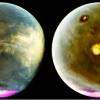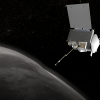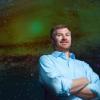Space
 New global images of Mars from NASA’s Mars Atmosphere and Volatile Evolution (MAVEN) mission being led by CU Boulder show the ultraviolet glow from the Martian atmosphere in unprecedented detail, revealing dynamic, previously invisible behavior.
New global images of Mars from NASA’s Mars Atmosphere and Volatile Evolution (MAVEN) mission being led by CU Boulder show the ultraviolet glow from the Martian atmosphere in unprecedented detail, revealing dynamic, previously invisible behavior. Today, NASA’s Mars Atmosphere and Volatile EvolutioN (MAVEN) mission, which is being led by the University of Colorado Boulder, completed one Mars year of science observations. One Mars year is just under two Earth years.
Today, NASA’s Mars Atmosphere and Volatile EvolutioN (MAVEN) mission, which is being led by the University of Colorado Boulder, completed one Mars year of science observations. One Mars year is just under two Earth years. If you gaze at the night sky from Earth in just the right place, you will see the International Space Station (ISS), a bright speck of light hurtling through space at 5 miles per second as it orbits 220 miles above the planet. And if you were an astronaut floating around inside the station, you would see high-tech hardware and experiments designed and built at CU Boulder.
If you gaze at the night sky from Earth in just the right place, you will see the International Space Station (ISS), a bright speck of light hurtling through space at 5 miles per second as it orbits 220 miles above the planet. And if you were an astronaut floating around inside the station, you would see high-tech hardware and experiments designed and built at CU Boulder. A NASA mission involving CU Boulder was successfully launched from Cape Canaveral, Florida, at 5:05 p.m. MDT Thursday night and is on its way to explore an asteroid, setting the stage for a better understanding of the evolution of our solar system.
A NASA mission involving CU Boulder was successfully launched from Cape Canaveral, Florida, at 5:05 p.m. MDT Thursday night and is on its way to explore an asteroid, setting the stage for a better understanding of the evolution of our solar system. NASA’s OSIRIS-REx mission, set for launch Sept. 8 and which involves CU Boulder researchers, is designed to snag a sample from the surface of a near-Earth asteroid for study. The spacecraft will fly more than 1 billion miles in two years before reporting for duty at the asteroid known as Bennu.
NASA’s OSIRIS-REx mission, set for launch Sept. 8 and which involves CU Boulder researchers, is designed to snag a sample from the surface of a near-Earth asteroid for study. The spacecraft will fly more than 1 billion miles in two years before reporting for duty at the asteroid known as Bennu. Capitalizing on its reputation as a top public university in space research, CU Boulder has launched a brand new Space Minor program for all undergraduate students. Students are invited to learn more at an event 7 p.m. Thursday, Sept. 1, at the Fiske Planetarium. The event will feature astronaut Jim Voss - and pizza and drinks.
Capitalizing on its reputation as a top public university in space research, CU Boulder has launched a brand new Space Minor program for all undergraduate students. Students are invited to learn more at an event 7 p.m. Thursday, Sept. 1, at the Fiske Planetarium. The event will feature astronaut Jim Voss - and pizza and drinks. Three of the four honorees being inducted into the inaugural Colorado Space Heroes Hall of Fame are CU alumni. The recognition is bestowed upon leaders who've "contributed most significantly to the evolution, success and development of Colorado’s space economy as one of the most important in the nation and world."
Three of the four honorees being inducted into the inaugural Colorado Space Heroes Hall of Fame are CU alumni. The recognition is bestowed upon leaders who've "contributed most significantly to the evolution, success and development of Colorado’s space economy as one of the most important in the nation and world." A new $3 million sponsorship by Lockheed Martin announced Thursday will establish academic programs focused on radio frequency (RF) systems. RF fields address commercial, civil and military needs for communications, radar and photonics. For students, the partnership means even more opportunities to get real-world experience in tracking, navigation and spacecraft control as well as next-generation global navigation technologies.
A new $3 million sponsorship by Lockheed Martin announced Thursday will establish academic programs focused on radio frequency (RF) systems. RF fields address commercial, civil and military needs for communications, radar and photonics. For students, the partnership means even more opportunities to get real-world experience in tracking, navigation and spacecraft control as well as next-generation global navigation technologies. A solar storm that jammed radar and radio communications at the height of the Cold War could have led to a disastrous military conflict if not for the U.S. Air Force’s budding efforts to monitor the sun’s activity, a new study finds.
A solar storm that jammed radar and radio communications at the height of the Cold War could have led to a disastrous military conflict if not for the U.S. Air Force’s budding efforts to monitor the sun’s activity, a new study finds. Nearly 750,000 asteroids and comets have been discovered in the solar system, but most are known only by relatively bland numerical designations. This is not the case for the asteroid formerly known as 1998 OS14. The rocky binary asteroids orbiting the sun are now officially dubbed (46829) McMahon after CU Boulder Professor Jay McMahon.
Nearly 750,000 asteroids and comets have been discovered in the solar system, but most are known only by relatively bland numerical designations. This is not the case for the asteroid formerly known as 1998 OS14. The rocky binary asteroids orbiting the sun are now officially dubbed (46829) McMahon after CU Boulder Professor Jay McMahon.


